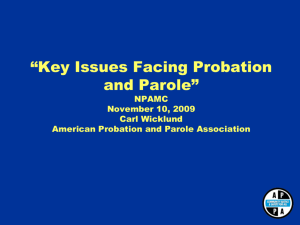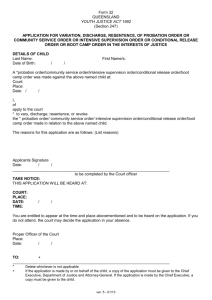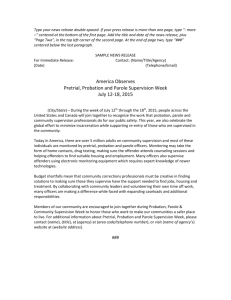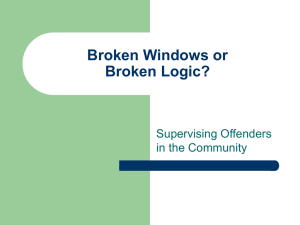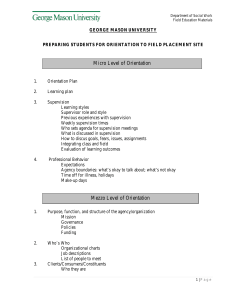The Effects of Sanction Intensity on Criminal Conduct A
advertisement
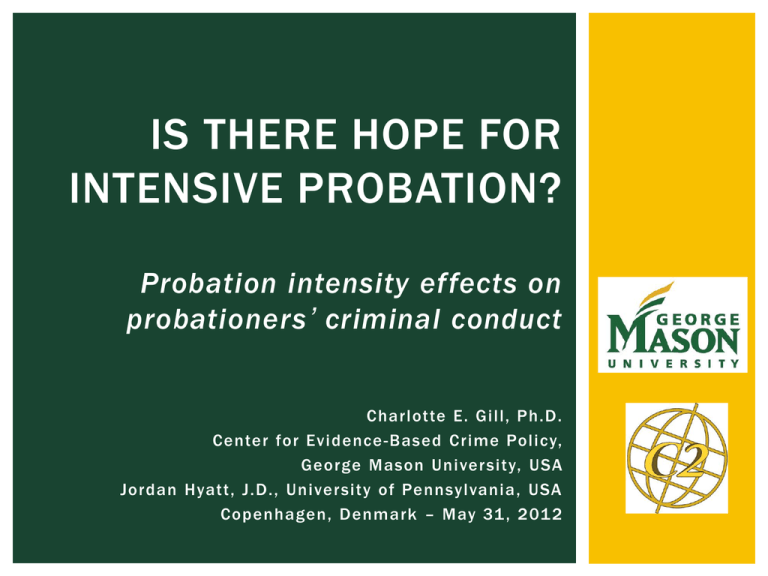
IS THERE HOPE FOR INTENSIVE PROBATION? Probation intensity effects on probationers’ criminal conduct Charlotte E. Gill, Ph.D. Center for Evidence -Based Crime Policy, George Mason Univer sity, USA Jordan Hyatt, J.D., Univer sity of Pennsylvania, USA Copenhagen, Denmark – May 31 , 201 2 ACKNOWLEDGEMENTS David B. Wilson Lawrence Sherman John M. MacDonald Jerry Lee PROBATION IN THE UNITED STATES One of the most frequently -used criminal sanctions 83% of all adults under community supervision on probation (4 million) at end 2010 1 in 48 US adults on probation or parole Probation population is currently declining, but grew by more than half a million 2000-2008 PROBATION OUTSIDE THE UNITED STATES United Kingdom Approx. 233,000 supervised by probation service at end 2011 Approx. 47% pre- or post-release Denmark Approx. 8,500 under supervision per day 3,000 inmates released on parole each year Electronic monitoring as prison alternative Growing prison population is a concern in many Western societies PROBLEMS IN PROBATION Poor public perception as ‘soft’ approach to crime Struggle to access sufficient funding Need effective practices that use scarce resources efficiently Considerable research on programming but little on supervision IMPORTANCE OF SUPERVISION Foundation of programming Potentially the only interaction between client and agency Surveillance and control Does this deter recidivism or increase likelihood of detection? Purpose: related to risk and need or determined by operational capabilities? INTENSIVE SUPERVISION PROBATION Increase in supervision intensity should result in improved outcomes for high-risk offenders – ‘more is better’ Earliest interventions: rehabilitative focus Bulk of research: control-based programs More recent studies indicate increased sensitivity to principles of effective intervention Linkage between supervision and treatment IS INTENSIVE SUPERVISION EFFECTIVE? Intensive supervision programs: cost -saving, but no theoretical foundation Evaluations of programs show mixed results at best Studies with a treatment component show promise What is the effect of intensive supervision vs. ‘supervision as usual?’ RESEARCH QUESTIONS How does supervision intensity affect probationers ’ subsequent offending? Does program philosophy influence the success or failure of changes in supervision intensity? Does probationer risk level affect responses to changes in intensity? What other program components or offender characteristics moderate the overall effect of supervision intensity on crime? DATA & METHODS Systematic search for studies 1950s -present Studies of intensive probation compared to ‘supervision as usual,’ crime outcomes Focus on most rigorous evidence Randomized controlled trials and quasi-experiments using subject-level matching. Searches of electronic databases, agency websites, and journals. Meta-analytic techniques for combining studies. ELIGIBILIT Y CRITERIA Study tests the ef fect of a change in intensity of post conviction probation or parole supervision on recidivism Ratio of clients to probation officers (caseload size) Frequency of contact Frequency of other supervisory controls (e.g. drug testing) Primary supervisor is a probation of ficer Comparison condition is regular supervision practice All of fender characteristics and of fense types At least one arrest/conviction/technical violation outcome SEARCH RESULTS STUDIES INCLUDED IN THE REVIEW 47 treatment-control contrasts 38 randomized trials 9 quasi-experiments Almost all in USA Most 1990s or earlier Enhanced probation compared to supervision as usual ISP HAS NO EFFECT ON ARRESTS (RCTs) ISP HAS NO EFFECT ON ARRESTS (QEs) ISP INCREASES TECHNICAL VIOLATIONS (RCTs) ISP INCREASES TECHNICAL VIOLATIONS (QEs) IN ‘REAL WORLD’ TERMS… Arrests In RCTs, no difference between ISP and supervision as usual In quasi-experiments, ISP participants 11% less likely to be rearrested than regular probationers Technical violations In RCTs, ISP participants 24% more likely to be violated than regular probationers In quasi-experiments, ISP participants 15% more likely to be violated than regular probationers NO EFFECT OF SELECTED MODERATORS Overall effectiveness of ISP not altered by Supervision philosophy Risk levels of participants Study characteristics Program characteristics Sample characteristics Degree of intensity change CONCLUSIONS Traditional ISP ineffective under most conditions Increases technical violations – increased surveillance? Difficulty of implementing ISP in practice Lack of knowledge about what to do with the extra time Backfire effect of heavy enforcement – defiance? ISP with treatment component is promising Limitation: difficulty in capturing variation between programs IMPLICATIONS: WHAT CONSTITUTES EFFECTIVE SUPERVISION? Key: behavioral management rather than ‘search for the magic number’? Maryland PCS program service brokerage and case planning primarily treatment-based Hawaii HOPE program enforcement and deterrence focused multiple violators are directed to treatment Forthcoming research to further explore the effects of behavioral management style probation Still unknown: effective elements of the officer -client interaction
